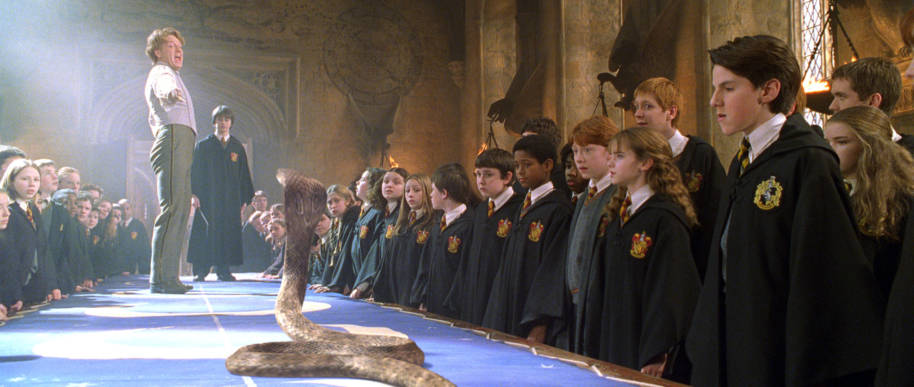Spoiler warnings should be heeded in this article.
Roughly translated, Expelliarmus – the Disarming Charm – means ‘to drive out a weapon’ and that’s what it does: forces the subject to drop whatever they’re holding. Usually that’s a wand, which is why it’s often seen in duels, and Harry definitely took that to heart, given how much he used it in combat. Harry became so enamoured with the spell that he eventually used it to finish off Lord Voldemort. Here’s how Harry’s relationship with Expelliarmus became his signature – and why that’s a good and bad thing.
Professor Snape taught Harry the spell
It was during Professor Lockhart’s short-lived Duelling Club that Harry learned the spell that would define him. Not from Lockhart (of course) but from Snape. In the second year, we knew Snape as the bad-tempered Potions Master who supposedly hated Harry, but it’s interesting to think it was this brave former follower of Voldemort who taught Harry the spell that toppled the Dark Lord.

Learning Expelliarmus
Spells are tricky things. Harry took a while to get to grips with the Summoning Charm he used in the first Triwizard task and even Hermione struggled with her Patronus. So the fact that Harry quickly developed an aptitude for Expelliarmus could explain why he was confident enough to use it in challenging situations. Within months of learning it, Harry used Expelliarmus to get Riddle’s diary back from Malfoy and to disarm Lockhart, plus he spent the final hours of second year practicing it, getting very good in the process.
Harry also successfully used Expelliarmus when he disarmed Snape in the Shrieking Shack and when he made a giant spider release him during the third Triwizard task, but it wasn’t until he turned it against Voldemort that it started to become associated with him – and that, as Lupin later implied, was where the danger lay.

Disarming Lord Voldemort
When Harry took Hermione and Ron to task over the offhand way they listed all the times he’d defeated Voldemort, he told them:
‘I got through it all because – because help came at the right time, or because I guessed right – but I just blundered through it all, I didn’t have a clue what I was doing…’
Harry Potter and the Order of the Phoenix
That moment in the graveyard was a case in point. As Voldemort forced Harry to duel, he remembered Expelliarmus. Surrounded by Death Eaters, with Voldemort prepared to kill him, he was aware a Disarming Charm wasn’t going to get him very far and yet it was all he had – that, and a refusal to die without at least trying to defend himself.
As it happened, he guessed right, although since he didn’t actually manage to disarm Voldemort that was actually more to do with Priori Incantatem. Still, to put it in Harry’s words, he blundered through, aided by the shadowy echoes of Voldemort's victims.
How it became his 'signature move'
The outcome of that scene may not have been to Voldemort’s liking, but he and his Death Eaters did witness Harry attempt to fight by Disarming and not Stunning. This came back to bite Harry, when he used Expelliarmus on an Imperiused Stan Shunpike during the Battle of the Seven Potters and inadvertently revealed himself. Lupin berated him for it:
‘Expelliarmus is a useful spell, Harry, but the Death Eaters seem to think it is your signature move, and I urge you not to let it become so!’
Harry Potter and the Deathly Hallows
It seems at least partly the case that Harry fell back on Expelliarmus because he’d used it to defeat Voldemort before – although he didn’t really, given the spell didn’t work. Still, that’s what he told Zacharias Smith when he sneered at Harry’s decision to teach the D.A. how to Disarm, and that’s what he told Lupin in defence of his actions against Stan: it saved him, so why wouldn’t it save others?
But it’s not the whole story. Harry might be confident with Expelliarmus; he might have an overdeveloped faith in it that makes him predictable – Lupin certainly thought so – but by this point it had also become as symbolic as it was practical.

Defeating The Dark Lord with his signature spell
As Harry told Lupin, if he’d Stunned Stan Shunpike as they were flying hundreds of feet above ground, ‘He’d have died the same as if I’d used Avada Kedavra!’
That’s what makes the difference. Disarming is about defence, not murder. Voldemort was a killer, Harry was not. It was an important distinction for Harry, who had learned so much about Voldemort and seen first-hand the ways in which they were similar. So while Lupin had a point, it’s a difference Harry owned: ‘I won’t blast people out of my way just because they’re there… that’s Voldemort’s job.’
In the final battle, Harry used his signature spell with defiance. This time he was more experienced but in some ways he was still guessing, with his assumptions about the Elder Wand. Still, when he shouted, ‘Expelliarmus!’ as Voldemort screamed, ‘Avada Kedavra!’ he was giving all those around him the message he gave Lupin: this was about ending bloodshed, not creating it.
Voldemort’s signature spell was Avada Kedavra. Harry’s was Expelliarmus. We know which we prefer.

